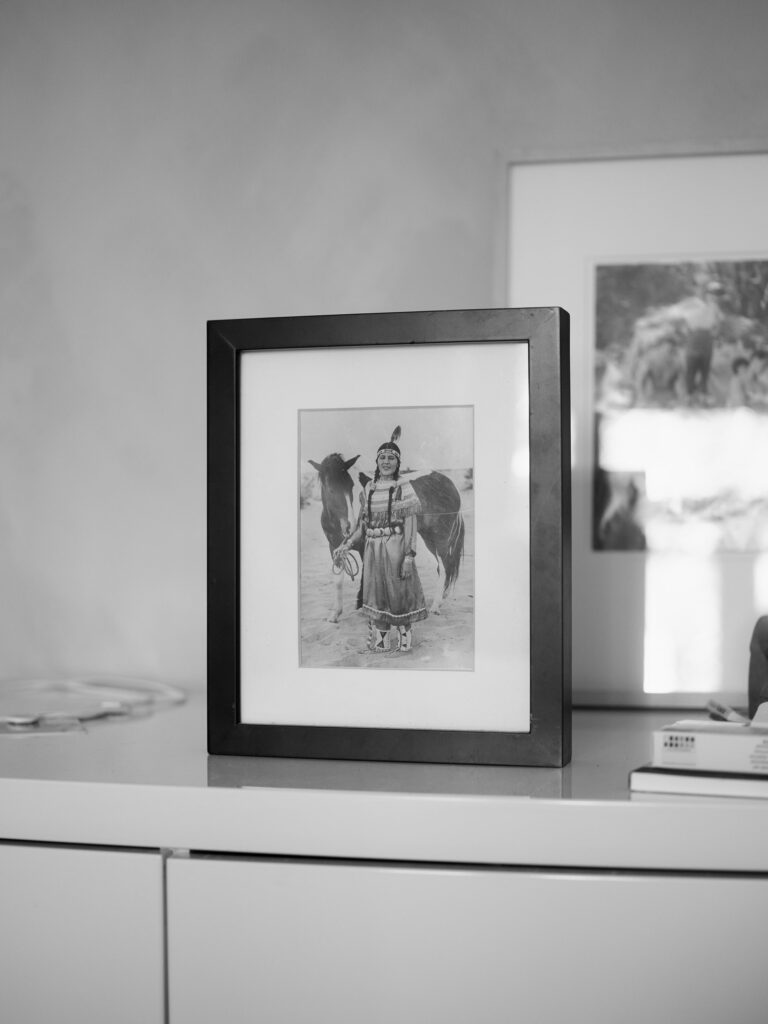A photographer asks: why bother making photographs?
I
I bought a photograph and hung it on my wall. The picture shows a woman holding the reins of a horse. I had found it in an archive in Paris, tucked inside a cardboard folder marked « l’Ouest Americain C19 ». The subject looks right at the camera, blinking. Her eyes could be closed on purpose, but the half-smile on her face convinced me that it was an accident.
Despite the mistake, this is the picture that was developed and printed. The woman has Native American features and a boxy shirt, a black headband, ankle boots adorned with beads and long, dark, straight hair from which a feather pokes. It’s unclear why the picture was taken, or how it relates to life at that time in her part of the world. The image is what you could consider « vernacular » 1 Since I found it in a box marked as containing pictures from the nineteenth-century American West, I took all of these characteristics at face value. I believed I was looking at an example of Native American life in the late 1800s, after a century of forced migration, subjugation and marginalisation. At the time when I bought it, I felt that photographs were assembled from components of an indisputable, incomparable real world, but now (as a photographer myself), I suspect every part of it — the light, the setting, the clothes, the expression.

I thought that from the middle of the nineteenth century onwards, the world would photograph itself forever. That it would image itself into greater self-awareness through an endless and increasingly broad flood of wet plates, snapshots, selfies and surveillance footage. Through this, I thought, we would reveal ourselves to our future, to our descendants, the increasing ease and accessibility of photography encouraging a sloppiness that would betray our true selves. In the corpus of effortless photography, our descendants could discover that some of us love artful lunches, or that others visit the Mona Lisa to take her picture. And we all take pictures of light itself: the sun coming up and going down, neon signs reflected in windows, light filtered through overlapping leaves.2
This article is behind the paywall. Want to keep reading this article?
Subscribe to the European Review of Books, from as low as €4,16 per month.
Already a subscriber? Sign in
- Vernacular photography is different from professional photography. It is conventionally understood as pictures of everyday life taken by an amateur without the intention of making art. Photography, even over a century ago, was comfortable with its role as a way to conserve a memory. ↩︎
- Which the Japanese call komorebi / 木漏れ日, and features in Wim Wenders’ film Perfect Days. By photographing komorebi, the main character is shown to be paying attention to small things. ↩︎
- Vernacular photography is different from professional photography. It is conventionally understood as pictures of everyday life taken by an amateur without the intention of making art. Photography, even over a century ago, was comfortable with its role as a way to conserve a memory. ↩︎
- Which the Japanese call komorebi / 木漏れ日, and features in Wim Wenders’ film Perfect Days. By photographing komorebi, the main character is shown to be paying attention to small things. ↩︎
- On YouTube, there is a beautiful short clip of HCB walking through Paris taking pictures. He wears a slim suit and holds his camera with the strap wrapped around one wrist. The clip focuses on the movements of his feet, crossing and uncrossing, and then on tiptoes. ↩︎
- Diane Arbus said « I really believe there are things nobody would see if I didn’t photograph them. » She sees things, but most importantly she photographs them. ↩︎
- Penn’s portable studios are in my estimation as beautiful as his subjects, though the only picture I could find was taken by Per Boije and held at the Art Institute of Chicago. It is impossibly romantic, showing the tent isolated and flapping on a plain in Nepal. The front end of a jeep is visible behind the tent, and the horizon is misty with film grain. ↩︎
- Roland Barthes, La chambre claire: Note sur la photographie (1980). ↩︎
- This is very, very roughly how diffusion techniques build images from nothing, hence the name of the most common open source model, Stable Diffusion. ↩︎
- Or #4682B4, or #B6D0E2, or #0000FF. A Hex code, or web colour code, uses a combination of six digits and/or letters to assign the 24 bits of the red, green, or blue channels. There are 16.777.216 colours with the sRGB (web) gamut. ↩︎